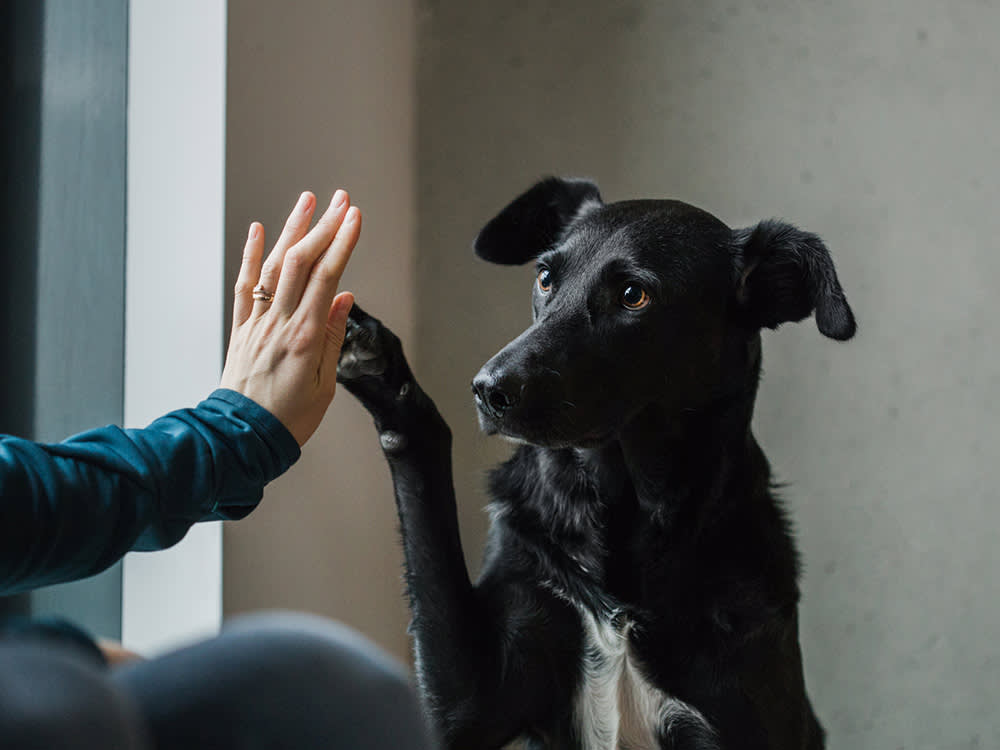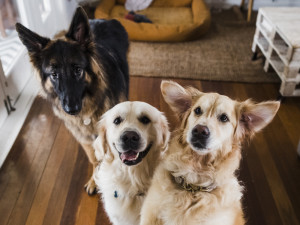15 Amazing Facts About Dogs You Might Not Know
Boost your dog smarts with these cool facts

share article
How much do you really know about dogs? From fastest dog to poop alignment, the fact is dogs have some incredible abilities. But did you know that they can even smell the passage of timeopens in a new tab? Yep, it’s true. Here are 15 incredible dog facts that you probably don’t know.
1. They have an incredibly fast sniff rate
A dog breathes in and out around 15 times per minute when sitting calmly, compared to a typical human who breathes out 12 to 20 breaths per minute. A dog's breathing frequency goes up to 31 times per minute while walking. But when a dog is actively sniffing, the inhalation/exhalation rate goes up to 140 to 200 times per minute.
2. Dogs communicate with more than vocals
Dogs do communicate with each other when they vocalise, bark or growl. But a more common means of communication between dogs is body language – an upright or tucked tail, forward ears, or tense body can speak volumesopens in a new tab.
3. Petting sessions relax shelter dogs
Researchers have confirmed that a quiet, 15-minute petting session can relax a shelter dog and result in positive behavioural and physiological changes.
4. Humping is more common among males
Studies from dog parks recorded that humpingopens in a new tab – or, more politely, mounting – was 16 times more frequent in male-male pairs as compared to female pairs.
5. How a dog greets varies by sex
Female dogs are more likely to greet other dogs by smelling the snout, or muzzle, first, while males go for the anogenital region. (You might be able to determine the sex of the dogs who greet your dog based on this behaviour alone.)
6. Paw preference may correlate to personality
Another cool fact about dogs relates to their paw preference. Dogs who show paw preference and those who are reported to be right-pawed are associated with lower arousal and calmer responses to novel stimuli and strangers.
7. Female dogs are better smellers
Is it true female dogs are better at smelling than males? The experts who wrote K9 Scent Training observed that to be the case – and research suggests this principle applies to humansopens in a new tab too.
8. Dogs are individuals
Not all Retrievers like to play fetch, or Pointers point at things. In fact, the seminal text Genetics and the Social Behavior of the Dog states that there is often greater variability between dogsopens in a new tab within the same breed than between breeds in temperament and talent.
9. Dogs are way better smellers than us
Dogs have 125 to 300 million olfactory cells (compared to our 5 million), and 33 percent of their brain is dedicated to interpreting odours. Frank Rosell, scientist and author of Secrets of the Snout, estimates that a dog’s nose is between 100,000 and 100 million times more sensitive than a human’s.
10. Gazing is good for both of us
A dog gazing into our eyes, and us looking into theirs, showed a marked increase in oxytocinopens in a new tab (the ‘love hormone’) levels in both humans and dogs. This is similar to mother-infant relationships.
11. Dogs come in vastly different sizes
The tallest dog on record is a Great Dane who stood 1.118 metresopens in a new tab tall, and the shortest dog was a Chihuahua measuring just 9.14 centimetres in height.
12. Dogs can smell the passage of time
According to researcher and author Alexandra Horowitz, “Dogs smell timeopens in a new tab.” Because of their extremely sensitive noses, dogs can smell the way odours change over time. They smell time as a complex layer of both new (stronger) and old (weaker) smells.
13. Dogs aren’t as fast as cats (sort of)
The cheetah, the world’s fastest land animal and a large cat of the subfamily Felinae, can race up to 121 kilometres per hour for short bursts. The Greyhound is the fastest canidopens in a new tab, with a peak speed of about 72 kilometres per hour.
14. Dogs can sense the earth’s magnetic field
When your dog is carefully choosing the perfect place to do his business, it is because they prefer to go poop in alignment with the earth’s magnetic field.
15. The origin of ‘the dog days of summer’
‘The dog days of summer’ are considered to be the hot, lethargic days of late July and early August. Ancient Greek and Roman astrology observed this period to coincide with the appearance of the star system Sirius – the Dog Staropens in a new tab.

Claudia Kawczynska
Claudia Kawczynska was co-founder and editor-in-chief of The Bark for 20 years. She also edited the best-selling anthology Dog Is My Co-Pilot.
Related articles
![]()
How to Teach Your Dog to ‘Talk’ at the Touch of a Button
Cognitive science professor Dr Federico Rossano on how Bunny, TikTok’s ‘talking’ dog, is sparking change in how we communicate with our pets
![A man in a blue t-shirt holding a super cute puppy against an orange background]() opens in a new tab
opens in a new tabBaby Face: The Allure of Cute Dogs
Kindchenschema might explain why pet parents anthropomorphise their cuddly companions
![Bernese Mountain Dog with tennis ball in his mouth play bowing in the grassy backyard]() opens in a new tab
opens in a new tabThe Universal Dog Signal That You’re Never Leaving the Park
Bow down, puppers. It’s time to play
![Dog with sleep startle reflex. Woman lays on her couch and gently wakes up her dog]() opens in a new tab
opens in a new tabWhy Does My Dog Freak Out When I Wake Them Up?
‘Let sleeping dogs lie’ is more than just a proverb










